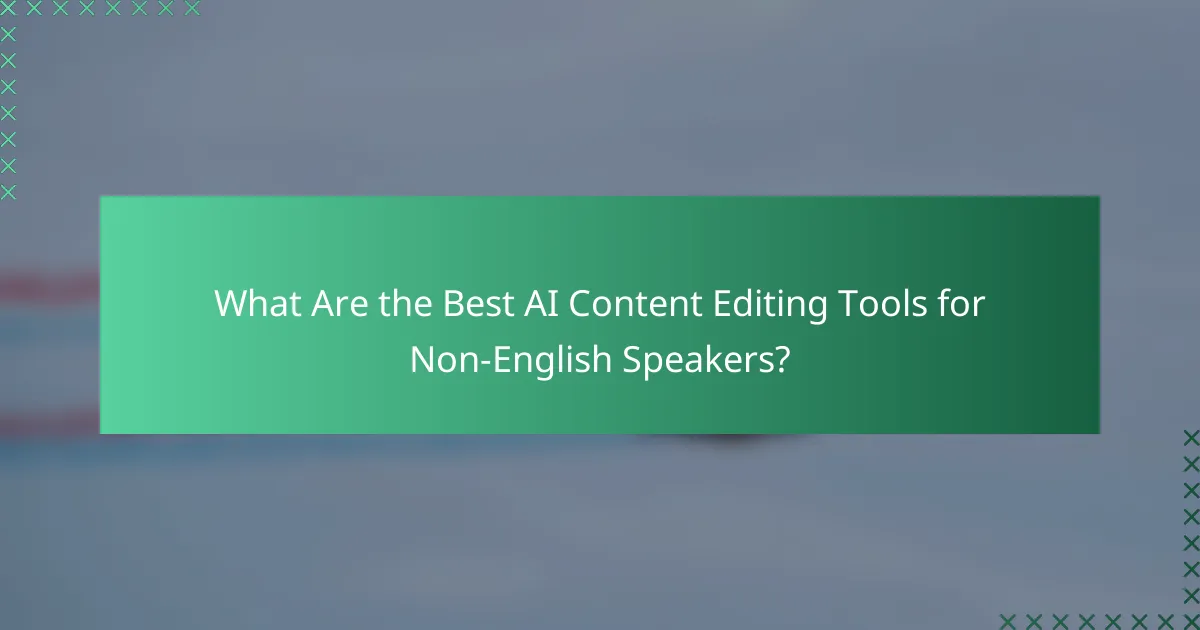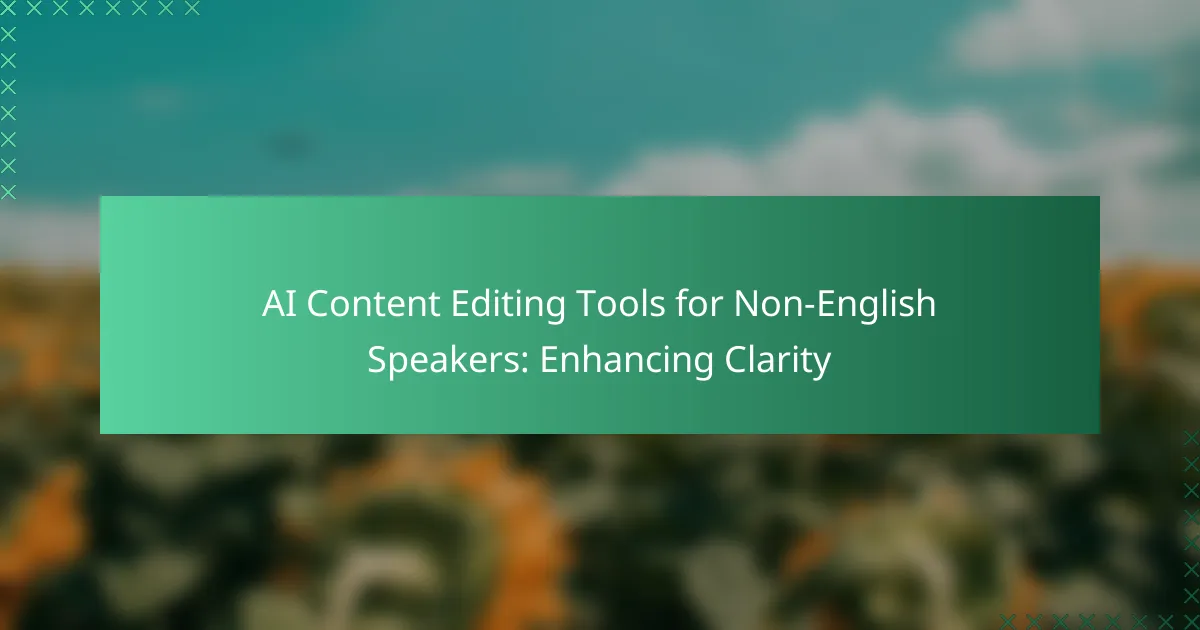AI content editing tools are invaluable for non-English speakers seeking to enhance their writing clarity and grammar. By automatically identifying and correcting language issues, these tools improve overall writing quality and facilitate effective communication. With features like multilingual support and contextual suggestions, they empower users to express themselves more clearly, regardless of their proficiency level.

What Are the Best AI Content Editing Tools for Non-English Speakers?
The best AI content editing tools for non-English speakers enhance writing clarity and grammar, making them essential for effective communication. These tools cater to various languages and offer features that help users improve their writing skills regardless of their proficiency level.
Grammarly
Grammarly is a widely used writing assistant that supports multiple languages, providing grammar, punctuation, and style suggestions. It offers a browser extension and desktop application, making it accessible for various writing platforms.
For non-English speakers, Grammarly’s real-time feedback helps identify common mistakes and suggests corrections. The premium version includes advanced features like tone detection and vocabulary enhancement, which can be particularly beneficial for nuanced writing.
ProWritingAid
ProWritingAid is a comprehensive editing tool that offers grammar checks, style suggestions, and in-depth reports on writing habits. It supports multiple languages and integrates with various writing software, including Microsoft Word and Google Docs.
This tool is ideal for non-English speakers looking to improve their writing skills over time. Its detailed reports provide insights into areas needing improvement, making it a great choice for those wanting to develop their language proficiency.
Ginger Software
Ginger Software focuses on grammar and spell checking while also offering translation features for non-English speakers. It supports multiple languages and provides a text reader that helps users hear their writing, which can improve understanding and fluency.
Additionally, Ginger’s sentence rephrasing tool can help users find alternative ways to express their thoughts, enhancing clarity and style. This feature is particularly useful for those who may struggle with language nuances.
LanguageTool
LanguageTool is an open-source grammar checker that supports over 20 languages, making it a versatile option for non-English speakers. It offers real-time suggestions for grammar, punctuation, and style, which can be particularly helpful for users writing in their second language.
LanguageTool can be integrated into various platforms, including web browsers and word processors. Its collaborative features allow users to work together on documents, making it a good choice for teams or educational settings.
Quillbot
Quillbot is primarily a paraphrasing tool that helps users reword sentences while maintaining their original meaning. It supports multiple languages and offers a summarization feature that can help non-English speakers condense lengthy texts into concise summaries.
This tool is beneficial for improving writing clarity and avoiding plagiarism. Users can adjust the level of rewriting, allowing for more control over the final output, which is useful for those looking to refine their language skills.

How Do AI Content Editing Tools Enhance Clarity?
AI content editing tools enhance clarity by automatically identifying and correcting language issues, improving overall writing quality for non-English speakers. These tools focus on grammar, style, and readability, making it easier for users to communicate effectively.
Grammar correction
Grammar correction tools analyze text for errors in syntax, punctuation, and word usage. They provide real-time suggestions to fix mistakes, which helps non-native speakers produce grammatically correct content. For example, a tool might highlight incorrect verb tenses or subject-verb agreement issues, offering alternatives to ensure accuracy.
When using grammar correction tools, it’s essential to review suggested changes carefully. Some tools may not fully understand context, leading to inappropriate corrections. Always double-check before accepting changes to maintain the intended meaning of your text.
Style suggestions
Style suggestions focus on improving the tone and voice of the writing. AI tools can recommend adjustments to make the text more engaging or appropriate for the target audience. For instance, they might suggest using active voice instead of passive voice to create a more dynamic narrative.
To effectively utilize style suggestions, consider the audience and purpose of your writing. If the goal is to inform, a formal tone may be preferable, while a conversational style might suit a blog post. Regularly applying style recommendations can help develop a consistent writing style over time.
Readability improvements
Readability improvements assess how easily a text can be understood. AI tools often provide readability scores based on factors like sentence length and vocabulary complexity. Aiming for a score that indicates a grade level appropriate for your audience can enhance comprehension.
To improve readability, consider breaking long sentences into shorter ones and using simpler words where possible. Tools may suggest these changes, but it’s important to balance simplicity with the richness of your content. Aim for clarity without sacrificing depth or nuance.

What Features Should Non-English Speakers Look For?
Non-English speakers should prioritize features that enhance understanding and usability in their preferred language. Key aspects include multilingual support, contextual suggestions, and a user-friendly interface to facilitate effective communication and editing.
Multilingual support
Multilingual support is essential for non-English speakers as it allows them to work in their native language while accessing editing tools. Look for software that offers a wide range of language options, enabling seamless transitions between languages. This feature can significantly reduce misunderstandings and improve the overall editing experience.
When evaluating tools, check if they provide real-time translation or language-switching capabilities. Some platforms may also include localized spell-check and grammar correction, which can be particularly beneficial for maintaining accuracy in writing.
Contextual suggestions
Contextual suggestions help non-English speakers by providing relevant recommendations based on the text’s content and context. This feature can enhance clarity by suggesting synonyms, rephrasing sentences, or correcting idiomatic expressions that may not translate directly. Effective contextual suggestions can lead to more natural-sounding writing.
Choose tools that utilize advanced algorithms to analyze the context of your writing. This ensures that the suggestions are not only grammatically correct but also appropriate for the intended audience. Regularly reviewing and accepting these suggestions can improve writing skills over time.
User-friendly interface
A user-friendly interface is crucial for non-English speakers to navigate editing tools easily. Look for platforms that offer intuitive designs, clear icons, and straightforward navigation menus. A simple layout can reduce frustration and allow users to focus on content rather than getting lost in complex features.
Consider tools that provide tutorials or help sections in multiple languages. This support can assist users in understanding the functionalities without language barriers. Additionally, customizable settings that allow users to adjust the interface to their preferences can enhance overall usability.

How to Choose the Right AI Content Editing Tool?
Selecting the right AI content editing tool involves understanding your specific language needs, evaluating pricing options, and considering user feedback. Focus on tools that cater to your language proficiency and provide features that enhance clarity in your writing.
Assess your language needs
Begin by identifying the languages you will be working with and your proficiency level in each. Some tools specialize in certain languages or dialects, which can significantly impact the quality of edits and suggestions provided.
Consider whether you need basic grammar checks or more advanced features like style suggestions and readability enhancements. For example, if you primarily write in Spanish, look for tools that excel in Spanish grammar and vocabulary.
Compare pricing plans
AI content editing tools typically offer various pricing tiers, ranging from free versions with limited features to premium subscriptions that provide comprehensive editing capabilities. Evaluate what each plan includes and whether it aligns with your editing needs.
For instance, a monthly subscription might cost between €10 to €30, while annual plans often offer discounts. Determine if the additional features justify the higher cost based on your usage frequency and editing requirements.
Read user reviews
User reviews can provide insights into the effectiveness and reliability of different AI content editing tools. Look for feedback that discusses language support, ease of use, and the accuracy of suggestions.
Websites like Trustpilot or G2 can be valuable resources for gathering user experiences. Pay attention to comments regarding customer support and updates, as these factors can influence your overall satisfaction with the tool.

What Are the Limitations of AI Content Editing Tools?
AI content editing tools have several limitations that can affect their effectiveness for non-English speakers. These tools may struggle with language nuances, cultural context, and can lead to an over-reliance on technology, which can hinder the editing process.
Language nuances
Language nuances include idiomatic expressions, slang, and regional dialects that AI tools often fail to interpret correctly. For instance, a phrase that is common in one culture may not translate well or may carry a different connotation in another. Users should be cautious and review suggestions to ensure they maintain the intended meaning.
To improve clarity, consider using simpler language or standard expressions that are widely understood. This can help bridge the gap where AI tools may falter, ensuring that the content resonates with the target audience.
Cultural context
Cultural context plays a crucial role in effective communication, and AI tools may not fully grasp the subtleties of different cultures. For example, humor, politeness levels, and references can vary significantly between cultures, potentially leading to misunderstandings. It’s essential to incorporate local customs and social norms into the content.
When editing, take time to research cultural references relevant to your audience. This will enhance the content’s relatability and ensure it aligns with the readers’ expectations and experiences.
Over-reliance on technology
While AI content editing tools can be helpful, over-reliance on them can lead to a lack of critical thinking and personal touch in writing. Users may accept suggestions without questioning their appropriateness or accuracy, which can diminish the quality of the content. It’s important to balance AI assistance with human judgment.
To avoid pitfalls, always review AI-generated edits critically. Consider keeping a checklist of common errors or stylistic preferences that reflect your voice, ensuring that the final output maintains authenticity and clarity.

How Can Non-English Speakers Improve Their Writing Skills?
Non-English speakers can enhance their writing skills by utilizing AI content editing tools that focus on clarity and coherence. These tools provide real-time feedback, helping users refine their language and structure for better communication.
Utilizing AI Editing Tools
AI editing tools can significantly assist non-English speakers by offering suggestions for grammar, vocabulary, and style. These platforms analyze text and provide corrections or enhancements, making it easier to produce polished writing. Popular tools include Grammarly, ProWritingAid, and Hemingway Editor, which cater to various writing needs.
When using these tools, it’s essential to understand their limitations. While they can improve clarity, they may not always grasp context or cultural nuances. Therefore, combining AI assistance with personal judgment is crucial for effective writing.
Practicing Regularly
Consistent practice is vital for improving writing skills. Non-English speakers should set aside time each day to write, whether through journaling, blogging, or drafting emails. This regular engagement helps reinforce language learning and builds confidence.
Additionally, seeking feedback from native speakers or language tutors can provide valuable insights. Engaging in writing groups or online forums can also facilitate constructive criticism and support.
Learning Language Rules
Understanding the fundamental rules of the English language is essential for effective writing. Non-English speakers should focus on grammar, punctuation, and sentence structure to avoid common errors. Resources like online courses, grammar books, and language apps can aid in this learning process.
Familiarity with idiomatic expressions and colloquialisms can further enhance writing quality. Non-English speakers should expose themselves to various English materials, such as books, articles, and podcasts, to develop a more natural writing style.
Setting Clear Goals
Establishing clear writing goals can guide non-English speakers in their improvement journey. Goals may include mastering specific grammar rules, expanding vocabulary, or completing a certain number of writing pieces each month. Setting measurable objectives helps track progress and maintain motivation.
It’s beneficial to break larger goals into smaller, manageable tasks. For example, focusing on writing one paragraph a day can lead to significant improvements over time.
